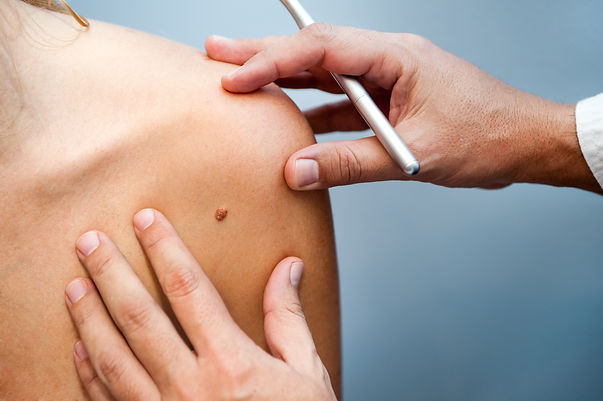
Skin Surgery
What to expect with skin surgery
Skin cancer operations can occur under local anaesthetic in our state-of-the-art procedure room at KM Surgical (Avenue Health) or under general anaesthesia at St George’s Hospital, Southern Cross Hospital or Forté Health. Occasionally, other modalities such as radiotherapy or immunotherapy are used.
We offer nitrous oxide (laughing gas) to make local anaesthetic procedures more comfortable. If you would like to avail of this, please make sure you have arranged transport to and from the clinic as you will not be able to drive.

A skin biopsy (punch or incisional) is when a doctor removes only a small part of a skin lesion for testing. A lesion is an area of damaged skin, like a mole, freckle, or spot. Excision is when the whole lesion is removed. In both cases, the skin is sent to the laboratory, where a specialist examines it under a microscope to find out if it's cancerous or not.
Scarring due to excision biopsy
It is impossible to fully excise a skin lesion without scarring in some way. Careful surgical technique should aim to minimise scarring, for example by taking the skin surface tension lines into account.
Some people have an abnormal response to skin healing and these people may get larger and thicker scars than usual (keloid or hypertrophic scarring).

What is involved in excision of a skin lesion?
Dr Mooney will explain to you why the skin lesion needs excision and the procedure involved. We will ask you to sign a consent form to indicate that you understand and agree to the surgical procedure. Please tell our team if you are taking any medication (particularly aspirin, clopidogrel, dabigatran and warfarin, which could make you bleed more), or if you have any allergies, medical conditions, or a pacemaker or implanted defibrillator. Remember, to tell Dr Mooney about any over-the-counter supplements or herbal remedies as a number of these can also lead to abnormal bleeding.

The most common type of excision is an elliptical excision. The ellipse is often designed so that the resulting scar runs parallel with existing skin creases. This usually provides a wound under less tension and orientates the scar in a direction which is less noticeable to the eye.
The area to be excised is marked with a surgical marker. A local anaesthetic injection will rapidly numb the area of skin involved and keep it numb during the procedure. Dr Mooney will then remove the lesion. The lesion is placed in formalin ready to go to the pathology laboratory. Here, a pathologist will process and examine the specimen under the microscope, and provide your doctor with a report approximately two weeks later.
It is normal to have some bleeding in the area from where the lesion has been removed during the surgery. The doctor may coagulate the blood vessels with a cautery. This can make a hissing sound and a burning smell, but will not be felt.
The edges of the ellipse will then be sewn together to make a thin suture line. This type of wound closure is called primary closure. There may be two layers of sutures (stitches) ¬ a layer underneath that is absorbable and a layer of sutures on the surface which will need to be removed in 5-14 days.
A dressing may be applied and instructions will be given on how to care for your wound and when to get the stitches out.
How do I look after the wound following skin excision?
Your wound may be tender 1–2 hours after the excision when the local anaesthetic wears off.
Leave the dressing in place for 48 hours or as advised by your Dr Mooney’s team. Avoid strenuous exertion and stretching of the area until the stitches are removed and for some time afterwards.
If there is any bleeding, press on the wound firmly with a clean folded towel without removing the existing dressing or looking at it for 20 minutes. If it is still bleeding after this time, seek medical attention.
Keep the wound dry for 48 hours. You can then gently wash and dry the wound. A small amount of pinkness and tenderness to touch around the wound edges is normal but, if the wound becomes increasingly red or painful, consult your Dr Mooney’s team promptly — it could be infected and need a course of antibiotics.
The scar will initially be red and raised but usually reduces in colour and size over several months.


